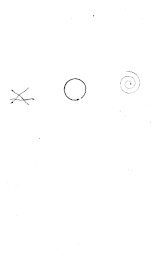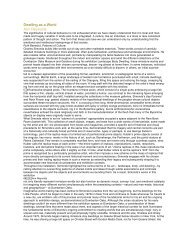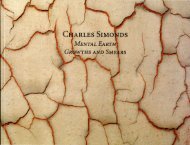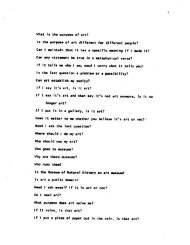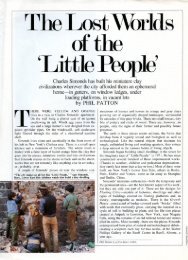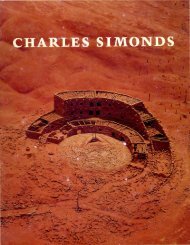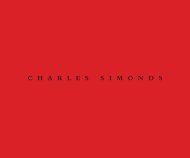A Nomad in the City Germano Celant
A Nomad in the City Germano Celant - Charles Simonds
A Nomad in the City Germano Celant - Charles Simonds
- No tags were found...
You also want an ePaper? Increase the reach of your titles
YUMPU automatically turns print PDFs into web optimized ePapers that Google loves.
A <strong>Nomad</strong> <strong>in</strong> <strong>the</strong> <strong>City</strong><strong>Germano</strong> <strong>Celant</strong>When Charles Simonds embarked on his artistic career between 1969 and 1971, he oper- ated <strong>in</strong> a sett<strong>in</strong>g that layoutside <strong>the</strong> traditional bounds of art: <strong>the</strong> street. He immediately sought to make his <strong>in</strong>terventions burst from a contextexperienced and shared by o<strong>the</strong>rs, by people outside of <strong>the</strong> world of art. His <strong>in</strong>tention was to create art everywhere,<strong>in</strong> all k<strong>in</strong>ds of sett<strong>in</strong>gs. Ever s<strong>in</strong>ce his first <strong>in</strong>terventions <strong>in</strong> <strong>the</strong> streets of New York (1972, fac<strong>in</strong>g page and top right),he has managed to avoid <strong>the</strong> distortions of <strong>the</strong> prist<strong>in</strong>e and aseptic space of <strong>the</strong> gallery or museum, creat<strong>in</strong>g worksthat have blended <strong>in</strong>to <strong>the</strong> landscape of <strong>the</strong> city—a sett<strong>in</strong>g where <strong>the</strong> public is not <strong>in</strong>veigled by <strong>the</strong> communicativepower of <strong>the</strong> sacred place, which makes <strong>the</strong> artistic object a separate entity; where <strong>in</strong>stead <strong>the</strong> work is immersed <strong>in</strong><strong>the</strong> chaos of life; and where <strong>the</strong> poetic and visual impulse is entrusted to its autonomous power of persuasion,without any defense. Urban space, with all of its communicative characteris- tics, is taken on for its centripetal force,prior to any artistic <strong>in</strong>tervention.Simonds chose <strong>the</strong> urban landscape for its tension and its secret power, which is not <strong>the</strong> repetitive power of <strong>the</strong>“white cube,” but one of drama and tragedy, of magic and s<strong>in</strong>gularity. His choice, which he shared with artists suchas Gordon Matta-Clark (bottom right), questioned <strong>the</strong> abstract and ideal dimensions of m<strong>in</strong>imal art.1 His aim was toreject <strong>the</strong> environmental homogenization of <strong>the</strong> <strong>in</strong>tervention and to enter <strong>the</strong> reality of <strong>the</strong> urban and architecturalconfiguration, thus <strong>in</strong>troduc<strong>in</strong>g <strong>the</strong> notions of hazard, risk, and chance and plung<strong>in</strong>g <strong>in</strong>to real life. To understand <strong>the</strong>boldness of this move away from <strong>the</strong> lifeless event and toward a regenerative immersion <strong>in</strong>to a territory where forcescome from below, it is necessary to describe <strong>the</strong> m<strong>in</strong>imalist tendency, with its mystical fasc<strong>in</strong>ation with <strong>the</strong> absolutedimension of forms and materials, of l<strong>in</strong>es and colors.|43The advent of m<strong>in</strong>imalism <strong>in</strong> 1963–64 marked <strong>the</strong> first attempt by artists to under- m<strong>in</strong>e <strong>the</strong> idea of <strong>the</strong> objectas an entity connected to <strong>the</strong> subjective impulse, typical of both nonrepresentational and figurative art after <strong>the</strong>Second World War, and to transfer it <strong>in</strong>to a limited processual territory reduced to its specific terms.2 Respond<strong>in</strong>g to abelief that <strong>the</strong> acquisition of personal values is fundamental to understand<strong>in</strong>g <strong>the</strong> motives of <strong>the</strong> artifact, m<strong>in</strong>imalismpresented a technique of verification that followed <strong>the</strong> logic of construction alone. Part of this constructive procedurewas <strong>the</strong> control of <strong>the</strong> whole of <strong>the</strong> environment, whe<strong>the</strong>r <strong>in</strong>side or outside architecture, which spurned any referenceto <strong>the</strong> real and everyday context <strong>in</strong> order to determ<strong>in</strong>e its spatial logic operationally. While deriv<strong>in</strong>g from <strong>the</strong> selfevidenttruths of <strong>the</strong> architectural, volumetric, and superficial data, it treated <strong>the</strong>m as only part of a reductive andelementary process of formation. Thus m<strong>in</strong>imal research concerned <strong>the</strong> factual and primary analysis of space.Investigation was carried out by detail<strong>in</strong>g, <strong>in</strong> a logical and rational manner, con- crete entities concern<strong>in</strong>g, first (<strong>in</strong> <strong>the</strong>period from 1964 to 1969), <strong>the</strong> location of <strong>the</strong> works of art, and later, <strong>the</strong> structure of <strong>the</strong> sett<strong>in</strong>g itself, understood asa place with four walls, a floor, and a ceil<strong>in</strong>g. The def<strong>in</strong>ition and practical enumeration of <strong>the</strong> volume, color, surfaceand support, and material and process of construction led to <strong>the</strong> cognitive formulation of a series of fundamentallyaniconic sett<strong>in</strong>gs. In a period still dom<strong>in</strong>ated by <strong>the</strong> chaotic assemblage and <strong>the</strong> free gesture, as well as by <strong>the</strong> popuse of imagery, <strong>the</strong> m<strong>in</strong>imal art- ists—whe<strong>the</strong>r sculptors or pa<strong>in</strong>ters—rehabilitated a rigorous formalism, impersonalsimplicity, and tightly controlled technique. Their adoption of formalism and <strong>the</strong>ir reductive attitude shifted <strong>the</strong> focusfrom what was made and found to <strong>the</strong> construction and forma- tion of an object, while <strong>the</strong>ir choice of simple andmonolithic forms was a move away from <strong>the</strong> haphazard fragmentation of <strong>the</strong>ir surround<strong>in</strong>gs.The move from symbolic and metaphorical composites to constructive <strong>in</strong>gredients and from complex results toelementary entities was <strong>in</strong>spired by <strong>the</strong> ideas of John Dewey and Ludwig Wittgenste<strong>in</strong>, who applied empirical andlogical methods <strong>in</strong>stead of romantic and abstractly irrational ones. The analytical tendency of m<strong>in</strong>imal art co<strong>in</strong>cidedsubstantially with empiricist tendencies, restrict<strong>in</strong>g its <strong>in</strong>vestigations to observable facts and to <strong>the</strong> rela- tion amongthose facts. For <strong>the</strong> m<strong>in</strong>imalists, <strong>the</strong> only way to <strong>in</strong>tervene <strong>in</strong> <strong>the</strong> material was to consider it from <strong>the</strong> perspective ofquantitative measurement and logical structur<strong>in</strong>g. This structural read<strong>in</strong>g takes <strong>in</strong>to consideration <strong>the</strong> possiblel<strong>in</strong>guistic “<strong>in</strong>tersections” of <strong>the</strong> <strong>in</strong>di- vidual sett<strong>in</strong>g and <strong>the</strong> systems of subdivision and partition, which are determ<strong>in</strong>edby its own two- and three-dimensional characteristics, and applies <strong>the</strong>m to <strong>the</strong> given space, so that44|<strong>Germano</strong> <strong>Celant</strong>every spatial or artistic practice has to be studied <strong>in</strong> situ. The m<strong>in</strong>imalists sought a greater critical awareness of <strong>the</strong>phenomenon of <strong>the</strong> “environment” seen as a monolithic whole. Between 1967 and 1970, <strong>the</strong> environment wasdef<strong>in</strong>ed through a series of new terms, which established an equivalence of significance between architecturalstructures and artistic compositions. This procedure is illustrated by works set <strong>in</strong> environments by Dan Flav<strong>in</strong>, CarlAndre, Donald Judd, Sol LeWitt (<strong>in</strong>stallation at Saman Gallery, Genoa, 1975, fac<strong>in</strong>g page), and Richard Serra <strong>in</strong> <strong>the</strong>United States and Daniel Buren (<strong>in</strong>stallation at Galleria Apoll<strong>in</strong>aire, Milan 1968, top right) and Bl<strong>in</strong>ky Palermo <strong>in</strong>Europe. Alternately, <strong>the</strong> def<strong>in</strong>ition was estab- lished with descriptive enunciations of environmental structures already<strong>in</strong> use. Examples of this practice, which is based on <strong>the</strong> tautology between artistic <strong>in</strong>tervention and <strong>the</strong> factual truthof <strong>the</strong> architectural space, are provided by <strong>the</strong> creations of Michael Asher, Robert Irw<strong>in</strong>, James Turrell, DougWheeler, Bruce Nauman, Eric Orr, and Maria Nordman.It was <strong>in</strong>to this climate of research that Simonds entered, understand<strong>in</strong>g, <strong>in</strong> part after his encounter with Christo, thatart is not a free zone, an antagonistic space wedged <strong>in</strong>to <strong>the</strong> social organism, an almost magical hollow, or a limbothat grows out of and feeds on “ano<strong>the</strong>r” breath, as proposed by m<strong>in</strong>imal art. Ra<strong>the</strong>r, art is someth<strong>in</strong>g that concernsa total spectacle of life and that avoids <strong>the</strong> absolute and virtual space <strong>in</strong> order to come <strong>in</strong>to direct contact with amore real reality. It is a com<strong>in</strong>g <strong>in</strong>to <strong>the</strong> world that starts <strong>in</strong> <strong>the</strong> bowels of <strong>the</strong> earth, as exemplified <strong>in</strong> Birth (1970) and
Landscape/Body/Dwell<strong>in</strong>g (1973, right). These works are permeated by a passion for location and by an energy andforce of gravity that nails <strong>the</strong> artifact (<strong>the</strong> artfully made object) to <strong>the</strong> ground. The birth, <strong>in</strong> order to take place, has toemerge from <strong>the</strong> womb of a specific place; it formulates an attitude that avoids <strong>the</strong> <strong>in</strong>human, that is, technologicaland scientific, sources of m<strong>in</strong>imalism.When an artist is <strong>in</strong>vited by a museum or an <strong>in</strong>stitution to exhibit one of his works, he is provided with a series of“prepackaged” sett<strong>in</strong>gs and times whose mean<strong>in</strong>gs are complex and varied—<strong>the</strong>y are metasigns of <strong>the</strong> artisticsociocultural system. Normally he nei<strong>the</strong>r questions nor considers <strong>the</strong>m; he passively and simply places and arrangeswith<strong>in</strong> <strong>the</strong>m a number of aes<strong>the</strong>tic and l<strong>in</strong>guistic fill<strong>in</strong>gs, often of an architectural character. He displays his work <strong>in</strong>accordance with <strong>the</strong> prearranged grids and, even if he alters <strong>the</strong> micro- structures of <strong>the</strong> artistic object with m<strong>in</strong>imalvariation, he does not disrupt or question <strong>the</strong> generalized and approved macrostructures of <strong>the</strong> given spaces andtimes. Only Daniel Buren <strong>in</strong> France and Michael Asher <strong>in</strong> California—who were conscious that it was not just <strong>the</strong><strong>the</strong>ory and practice of art that organized and produced l<strong>in</strong>guistic modifications <strong>in</strong> its context, but also <strong>the</strong> plane of <strong>the</strong>environmental and temporal arrangement and location ofA <strong>Nomad</strong> <strong>in</strong> <strong>the</strong> <strong>City</strong> |45<strong>the</strong> work—rejected <strong>the</strong> passive role and proposed a process that, utiliz<strong>in</strong>g spaces and times (although <strong>in</strong> an alteredsense), brought <strong>in</strong>to question <strong>the</strong> prefigurations imposed by <strong>the</strong> art system as a social and cultural, as well asideological, framework.They systematically refused to submit to configured environmental schemes and temporal processes. Instead ofpassively accept<strong>in</strong>g an operative vision and practice that had been shaped over <strong>the</strong> years by exhibition venues,<strong>the</strong>se artists cut down every established environmental system, break<strong>in</strong>g it to cont<strong>in</strong>ually weaken <strong>the</strong> constitutednorms and to leave room for alternative uses. The breakup was achieved by mak<strong>in</strong>g <strong>the</strong> relationship between <strong>the</strong>environmental structures and <strong>the</strong> variations of forms and sequences dialectical, so that <strong>the</strong>y could circularly impose<strong>the</strong>ir logic on <strong>the</strong> preexistent architectural configurations. In this way, <strong>in</strong> relation to <strong>the</strong> different architectural andchronological conditions, a preestab- lished def<strong>in</strong>ition of <strong>the</strong> work of art cannot exist. Each <strong>in</strong>tervention and locationis dialectical. Unlike <strong>the</strong> dis<strong>in</strong>tegrat<strong>in</strong>g hypo<strong>the</strong>ses and practices, <strong>the</strong>y occupy an environmental space and a time,but are simultaneously occupied and determ<strong>in</strong>ed by <strong>the</strong>m.S<strong>in</strong>ce 1969, Simonds has also made his action hold a dialogue with context. But his action is not projected onto <strong>the</strong>traditional system of art—<strong>the</strong> museums and galleries, with <strong>the</strong>ir ascetic and metaphysical approach that negates <strong>the</strong>desire to <strong>in</strong>teract with <strong>the</strong> real and <strong>the</strong> everyday. From 1971 onward, he opted <strong>in</strong>stead for <strong>the</strong> jagged landscape and<strong>the</strong> urban ru<strong>in</strong>, start<strong>in</strong>g with <strong>the</strong> Lower East Side <strong>in</strong> New York, a tragic and ru<strong>in</strong>ous <strong>the</strong>atrical sett<strong>in</strong>g where life wasscarred by violence and poverty. Here <strong>the</strong> artist entered <strong>in</strong>to dialogue with <strong>the</strong> worn and flak<strong>in</strong>g walls of decrepitbuild<strong>in</strong>gs, with <strong>the</strong>ir walled and neglected gardens. He made reference, with his imag<strong>in</strong>ary civilization of Little People,to <strong>the</strong> kids of East Houston Street, and he tried to communicate to everyone <strong>the</strong> unprecedented and magicalcharacter of his microconstructions of villages and houses, which were <strong>the</strong> qu<strong>in</strong>tessence of and a metaphor for anomadism that also def<strong>in</strong>ed <strong>the</strong> artist himself. And while he has cont<strong>in</strong>ued to create sculptural “islands” on which heerects fantastic build<strong>in</strong>gs, his action has always been centered on <strong>the</strong> street. In 1975, he <strong>in</strong>filtrated areas of Genoawith bad reputa- tions as haunts of prostitution, while <strong>in</strong> Paris he marked his passage onto <strong>the</strong> decay<strong>in</strong>g scene of <strong>the</strong>Passage Julien Lacroix and <strong>the</strong> Rue des Cascades.He has also ventured <strong>in</strong>to <strong>the</strong> American landscape, erect<strong>in</strong>g several dwell<strong>in</strong>gs and a Growth House (page 19) atArtpark <strong>in</strong> Lewiston, New York, <strong>in</strong> 1974, and agree<strong>in</strong>g (though only rarely) to make use of <strong>the</strong> environmentalpanorama offered by museums and <strong>in</strong>stitutions such as PS1, Long Island <strong>City</strong> (left), or <strong>the</strong> Whitney Museum ofAmerican Art, New York, <strong>in</strong> 1975. While do<strong>in</strong>g so, however, he tried to break out of <strong>the</strong> traditional exhibition scene.He displayed46|<strong>Germano</strong> <strong>Celant</strong><strong>the</strong> constructive energy of his Little People on an open part of <strong>the</strong> terrace at PS1, and he found a way ofemphasiz<strong>in</strong>g <strong>the</strong>ir nomadism by locat<strong>in</strong>g <strong>the</strong>ir dwell<strong>in</strong>gs <strong>in</strong> a recess of <strong>the</strong> <strong>in</strong>ner stair- case, outside <strong>the</strong> galleries, at<strong>the</strong> Whitney Museum of American Art. In 1976, at <strong>the</strong> American Museum of Natural History, New York, he establisheda relationship with archaeological and historical objects, such as models of Aztec temples, present<strong>in</strong>g <strong>the</strong> “‘L<strong>in</strong>earPeople,’ who live <strong>in</strong> a l<strong>in</strong>e and leave <strong>the</strong> past beh<strong>in</strong>d like a museum.” Alongside <strong>the</strong>m were <strong>the</strong> “‘Circular People,’ wholive <strong>in</strong> a circle, excavat<strong>in</strong>g <strong>the</strong> past and rebuild<strong>in</strong>g it <strong>in</strong>to <strong>the</strong>ir present,” and <strong>the</strong> “‘Spiral People,’ who bury <strong>the</strong> pastand use it as build<strong>in</strong>g material to try to make <strong>the</strong>ir dwell<strong>in</strong>g higher.”3 Yet <strong>the</strong> course he took was not always so official.In 1978, he went to East Berl<strong>in</strong> to create clandest<strong>in</strong>e artistic constructions, as <strong>the</strong> city was still under <strong>the</strong> control of<strong>the</strong> Russians and <strong>the</strong> sway of a realist art, an expression of ideology and <strong>the</strong> state.In 1981, he halted his descent <strong>in</strong>to <strong>the</strong> negative and <strong>the</strong> vacuum of <strong>the</strong> city <strong>in</strong> an attempt to construct someth<strong>in</strong>gthat was not threatened from <strong>the</strong> outside. Instead of accept- <strong>in</strong>g <strong>the</strong> transience and <strong>the</strong> fortuitousness of hislocations, Simonds “cut” his landscape <strong>in</strong>to walls and sett<strong>in</strong>gs, so that it no longer appeared to be a lost power butaspired to be a power that rema<strong>in</strong>ed. On <strong>the</strong> wall of <strong>the</strong> cafeteria—an “off space”—<strong>in</strong> <strong>the</strong> Museum of ContemporaryArt, Chicago, he created a canyon, where <strong>the</strong> architectural traces of <strong>the</strong> imag<strong>in</strong>ary civilization of <strong>the</strong> Little Peoplebecame permanent; this creation marked a shift from <strong>the</strong> fleet<strong>in</strong>g to <strong>the</strong> last<strong>in</strong>g that seemed to be a metaphor for <strong>the</strong>oscillation between death and life, a com<strong>in</strong>g and go<strong>in</strong>g between <strong>the</strong> two. As an effort to take on <strong>the</strong> world withoutsubmitt<strong>in</strong>g to it—to consent to a reappropriation of his work so as not to leave it to o<strong>the</strong>rs or <strong>in</strong> an unknownelsewhere— this led <strong>the</strong> artist to enrich his production of islands, on which pyramids, ritual towers, fortresses, mazes,and wilted towers appeared. These elements were no longer related to <strong>the</strong> desolate landscape of streets and
stairways—filled with <strong>the</strong> s<strong>in</strong>ister and violent, <strong>the</strong> troubled and precarious life of <strong>the</strong> city—but embodied “organic” life.From Priapus (1984) to Succulent (2001, right), seeth<strong>in</strong>g energies of a markedly erotic character began to appearthat condi- tioned <strong>the</strong> bustle of <strong>the</strong> architectural movements of <strong>the</strong> Little People. Compared to <strong>the</strong> more controlledand arid constructions of <strong>the</strong> 1970s, <strong>the</strong>se dwell<strong>in</strong>gs seemed to have taken on new life. Hav<strong>in</strong>g passed through aprocess of settl<strong>in</strong>g <strong>in</strong>to and <strong>in</strong>teract<strong>in</strong>g with <strong>the</strong> frenzied urban scene, <strong>the</strong>y now focused on <strong>the</strong>mselves <strong>in</strong> order to<strong>in</strong>corporate <strong>the</strong> psychological and orgias- tic aggregates of a different way of be<strong>in</strong>g <strong>in</strong> <strong>the</strong> world. From Pod No. 1 andPod No. 2 (1984) to House Plant No. 1 and House Plant No. 2 (1998), erotic exultation became manifest. Innerdrives were reflected, as fertiliz<strong>in</strong>g forces, <strong>in</strong> <strong>the</strong> articulation of <strong>the</strong> architecture, and <strong>the</strong> plunge <strong>in</strong>to <strong>the</strong> sensual andsexual evoked a vortex that permeated <strong>the</strong> fabulous life of <strong>the</strong> Little People.A <strong>Nomad</strong> <strong>in</strong> <strong>the</strong> <strong>City</strong> |47A Journey between Psyche and HistorySimonds does not oppose his practice to <strong>the</strong> tradition of sculpture <strong>in</strong> a simplistic manner, but cultivates it with <strong>the</strong>idea of a liv<strong>in</strong>g and mobile mode of action that contrasts with <strong>the</strong> <strong>in</strong>activity and immobility of objects produced as art.His work draws its life from <strong>the</strong> pneuma of <strong>the</strong> sett<strong>in</strong>g and <strong>the</strong> animat<strong>in</strong>g power of <strong>the</strong> location, as can be sensedfrom <strong>the</strong> fact that his dwell<strong>in</strong>gs have a lifetime related to <strong>the</strong> social life of <strong>the</strong> city. Far from form<strong>in</strong>g absolute andeternal entities, his constructions are l<strong>in</strong>ked to <strong>the</strong> flow of public reactions to <strong>the</strong>m. Sometimes defended andpreserved by locals and sometimes obliterated by locals because of <strong>the</strong>ir desire to possess <strong>the</strong>m, <strong>the</strong> dwell<strong>in</strong>gsregister both an attraction to magic and a yearn<strong>in</strong>g to destroy.In both cases, <strong>the</strong> public brought <strong>the</strong> constructions to life. If this was an essential part of <strong>the</strong> practice of art, <strong>the</strong>n itwas <strong>in</strong>evitable that Simonds would make his architectures brea<strong>the</strong> by giv<strong>in</strong>g <strong>the</strong>m a carnal and a human dimension.Start<strong>in</strong>g with Head (1991), S<strong>in</strong>g<strong>in</strong>g Monkey (1991, top left), Head (from I, Thou) (1993), and Man and Fish (1993), hetransformed clay <strong>in</strong>to flesh, crammed with portions of body, head, and mouth and congealed to frame a movement ofdance and contortion. This phase no longer dissociated <strong>the</strong> presence/absence of <strong>the</strong> bodies of <strong>the</strong> Little People,but gave <strong>the</strong>m concrete form <strong>in</strong> landscape and archi- tecture. In 1995, he elim<strong>in</strong>ated <strong>the</strong> double of <strong>the</strong> artifact so asto let <strong>the</strong> public speak and express <strong>the</strong>mselves. At <strong>the</strong> Centre d’Étude de l’Expression, Cl<strong>in</strong>ique des MaladiesMentales et de l’Encéphale <strong>in</strong> <strong>the</strong> Centre Hospitalier Sa<strong>in</strong>te-Anne, Paris, <strong>the</strong> artist created a sculpture <strong>in</strong>collaboration with <strong>the</strong> patients, jo<strong>in</strong>tly construct<strong>in</strong>g a sort of clay “cake” with imag<strong>in</strong>ary figures (bottom left). It wasano<strong>the</strong>r way of hold<strong>in</strong>g a dialogue and br<strong>in</strong>g<strong>in</strong>g art <strong>in</strong>to life, <strong>the</strong>reby obta<strong>in</strong><strong>in</strong>g an identity that was nei<strong>the</strong>r fictitiousnor unfounded, but ra<strong>the</strong>r l<strong>in</strong>ked to <strong>the</strong> flow of a different energy that found power <strong>in</strong> its larval character.In reject<strong>in</strong>g <strong>the</strong> false reality of art, Simonds passed through <strong>the</strong> threshold—be it a school, a city, a hospital, or a park—that <strong>the</strong> nomad crosses to enter <strong>the</strong> world. His work relied on <strong>the</strong> pact of mutual <strong>in</strong>volvement that was established<strong>in</strong> <strong>the</strong> <strong>in</strong>terval between <strong>the</strong> two territories and environments. In <strong>the</strong> new landscape that was opened up to <strong>the</strong> gaze,it is not hard to see <strong>the</strong> mix<strong>in</strong>g and <strong>in</strong>terweav<strong>in</strong>g. Everywhere fragments of constructions and mounta<strong>in</strong>s, ofpanoramas and valleys, of dismembered organs and figures, of rocks and plants form extensions, flames, anderuptions that spurt from <strong>the</strong> ground and wall. They are stalactites and stalagmites—dispersions of a curiousambivalence formed out of love and sensuality as well as rigidity and aggressiveness—that pour out of <strong>the</strong>ir sett<strong>in</strong>gs,rend<strong>in</strong>g <strong>the</strong>48|<strong>Germano</strong> <strong>Celant</strong>air and space. Swollen and protuberant islands, sparkl<strong>in</strong>g with <strong>the</strong>ir structural and natural- istic details, <strong>the</strong>y work <strong>the</strong>irway <strong>in</strong>to houses and rooms, museums and galleries, to present <strong>the</strong>mselves as comb<strong>in</strong>ations of <strong>the</strong> volatile and fixed,as places that are magnets for energy and <strong>the</strong> gaze (top right).By connect<strong>in</strong>g with various real contexts, Simonds counters <strong>the</strong> unreality of art, seen as an illusory and fictitiousentity with no aspiration to establish<strong>in</strong>g a relationship with <strong>the</strong> circumstances and situations <strong>in</strong> which it f<strong>in</strong>ds itselfoperat<strong>in</strong>g. He cont<strong>in</strong>ually gets <strong>in</strong> direct touch, without mediations and without filters, with <strong>the</strong> concrete andsociocultural entities of a place. As a consequence, his response has always been to take a stand with regard to <strong>the</strong>given situation—often do<strong>in</strong>g so outside of <strong>the</strong> traditional art world. Frequently risk<strong>in</strong>g <strong>the</strong> solitude and isolation thatstem from an <strong>in</strong>dependent operation that does not pass through <strong>the</strong> gallery and <strong>the</strong> art market, <strong>the</strong> artist is almostalways attracted not by <strong>the</strong> display of his works but by <strong>the</strong>ir <strong>in</strong>tegration <strong>in</strong>to a specific context that is not <strong>the</strong> “whitecube.” Thus, when <strong>in</strong>vited to present his work at Dumbarton Oaks, he had to deal with its history and its character asa museum—as a splendid historical complex with grounds laid out by Beatrix Farrand, with n<strong>in</strong>eteenth-centurybuild<strong>in</strong>gs stand<strong>in</strong>g alongside a modern structure by Philip Johnson, and with collections of Pre-Columbian andByzant<strong>in</strong>e artifacts and an extremely important library of rare and antique books.As <strong>in</strong> his o<strong>the</strong>r <strong>in</strong>terventions <strong>in</strong> situ, Simonds tried to communicate directly with <strong>the</strong> cultural and social character of thisprestigious location, develop<strong>in</strong>g angles of approach <strong>in</strong> such a way that his work was perceived as an element unifiedwith <strong>the</strong> build<strong>in</strong>gs and <strong>the</strong>ir natural sett<strong>in</strong>gs. He sought this connection so that his art would not appear as separateand different, but as a full participant <strong>in</strong> <strong>the</strong> historic complex of Dumbarton Oaks. He did not iso- late himself, butworked <strong>in</strong> a location that—ow<strong>in</strong>g to its character as a “nomadic” complex, spread out <strong>in</strong> time and space—seems tohave been deliberately created for his sculpture. The result was that his <strong>in</strong>stallation shared <strong>in</strong> <strong>the</strong> conditions ofexistence of <strong>the</strong> architec- tural and natural ensemble, and <strong>the</strong> two never stopped echo<strong>in</strong>g and respond<strong>in</strong>g to oneano<strong>the</strong>r. The artist, <strong>in</strong> fact, looked for a correspondence between his figures and <strong>the</strong> forms hidden among <strong>the</strong> lawns,hedges, founta<strong>in</strong>s, paths, and flowers; he <strong>in</strong>serted himself with <strong>the</strong> urban articulations of <strong>the</strong> Little People <strong>in</strong>to <strong>the</strong>real topography of <strong>the</strong> environmental routes. He made his work <strong>the</strong> meet<strong>in</strong>g place from which to read <strong>the</strong> visible and<strong>in</strong>visible of Dumbarton Oaks <strong>in</strong> a different way. He revealed <strong>the</strong> co<strong>in</strong>cidences and <strong>in</strong>tersections of signs and images
<strong>in</strong>scribed <strong>in</strong> <strong>the</strong> collections and <strong>in</strong> his sculpture. All of this turned <strong>in</strong>to a fusion that, <strong>in</strong> <strong>the</strong> Orangery, took <strong>the</strong> form ofMental Earth (bottom right), a climb<strong>in</strong>g sculpture thatA <strong>Nomad</strong> <strong>in</strong> <strong>the</strong> <strong>City</strong> |49blended <strong>in</strong>to <strong>the</strong> plants and creepers grow<strong>in</strong>g <strong>in</strong>side <strong>the</strong> conservatory. Like a cloud of mist that floated, poised <strong>in</strong> <strong>the</strong>air, without touch<strong>in</strong>g any of <strong>the</strong> walls, it mixed up <strong>the</strong>ir reciprocal textures. An airy architecture <strong>in</strong> which faces andmasks, pieces of body and architecture, were merged, it was a sort of “dream material” that created a tensionbetween natural and artificial, as it seemed to tackle <strong>the</strong> discont<strong>in</strong>uity between nature and <strong>the</strong> imag<strong>in</strong>ary activity of<strong>the</strong> Little People, who are also a metaphor for human civilization. This process of osmosis was repeated with Growth(top left) <strong>in</strong> <strong>the</strong> wisteria arbor, where <strong>the</strong> flows of <strong>the</strong> branches of <strong>the</strong> old v<strong>in</strong>e found an extension <strong>in</strong> <strong>the</strong> mixture ofnodes and jo<strong>in</strong>ts, <strong>the</strong> mixture of plant and architecture, with which Simonds sought to demonstrate that <strong>the</strong>coexistence of art and nature is possible, without ei<strong>the</strong>r predom<strong>in</strong>at<strong>in</strong>g over <strong>the</strong> o<strong>the</strong>r. Then <strong>the</strong> dwell<strong>in</strong>gs becameacts of a s<strong>in</strong>gular anthropology of <strong>in</strong>habitation. They strolled about <strong>in</strong> <strong>the</strong> ramified city and consented tocontam<strong>in</strong>ation by <strong>the</strong> ancient and profound branches of <strong>the</strong> v<strong>in</strong>e. It was a way of treat<strong>in</strong>g nature as if human be<strong>in</strong>gsand landscape were one and <strong>the</strong> same, form<strong>in</strong>g a new whole that represented a new civilization.Locat<strong>in</strong>g <strong>the</strong> sculptures on <strong>the</strong> grass or on branches was also a way of neutraliz<strong>in</strong>g <strong>the</strong> narcissism of <strong>the</strong> artist,whose presence disappeared <strong>in</strong> order to propose aga<strong>in</strong> a full condition of creativity, between <strong>the</strong> natural and <strong>the</strong>artificial. In this sense, a walk around Dumbarton Oaks was also an exploration of an alternative vision of itsexistence—one that was not only historical, but contemporary. It could be said that Simonds set out to give <strong>the</strong> placean anthropomorphic connotation <strong>in</strong> order to construct a human image of it, so that its physiognomy would assume<strong>the</strong> character of a body <strong>in</strong> flesh and blood. In addition, by scatter<strong>in</strong>g figures with a ruddy surface that had organicconnotations—such as Stugg (1991, bottom left), on <strong>the</strong> Founta<strong>in</strong> Terrace, with its almost sexual coupl<strong>in</strong>g of petals,body, and head, itself a mixture of mask, phantom, and goat’s head—<strong>the</strong> artist <strong>in</strong>vited an almost erotic <strong>in</strong>terpretationof <strong>the</strong> water and <strong>the</strong> founta<strong>in</strong>, turn<strong>in</strong>g <strong>the</strong> garden <strong>in</strong>to a territory of desire. Elsewhere, he <strong>in</strong>troduced a grim andmenac<strong>in</strong>g presence <strong>in</strong>to <strong>the</strong> route through <strong>the</strong> garden by hav<strong>in</strong>g a head peep out unexpectedly from <strong>the</strong> bushes <strong>in</strong><strong>the</strong> Rose Terrace (fac<strong>in</strong>g page, top); he uncovered <strong>the</strong> gloomy nature of <strong>the</strong> place, which is revealed to be <strong>the</strong>location of a cemetery where <strong>the</strong> ashes of <strong>the</strong> Blisses (<strong>the</strong> creators of Dumbarton Oaks) are buried. By mak<strong>in</strong>g <strong>the</strong>real world of Dumbarton Oaks and <strong>the</strong> imag<strong>in</strong>ary world of <strong>the</strong> Little People coex- ist, <strong>the</strong> artist misdirected <strong>the</strong>traditional systems of perception and made <strong>the</strong> environment poetic, relat<strong>in</strong>g it to a different civilization of dream andthought.But <strong>the</strong> quest for a correspondence between <strong>the</strong> imagery of <strong>the</strong> place and <strong>the</strong> art- ist’s sculptural <strong>in</strong>terventions(which were l<strong>in</strong>ked to his “conquest” of Dumbarton Oaks) has a50|<strong>Germano</strong> <strong>Celant</strong>mirrorlike effect. When explor<strong>in</strong>g <strong>the</strong> museum’s architecture and rich collections, Simonds’s gaze <strong>in</strong>evitably fell onarchaeological objects of Pre-Columbian cultures (from <strong>the</strong> Maya to <strong>the</strong> Aztecs), on Christian jewelry, and onByzant<strong>in</strong>e mosaics. This led him to exam<strong>in</strong>e <strong>the</strong> similarities between his action and a range of iconic histories,discover<strong>in</strong>g complexitiesthat opened up unexpected and surpris<strong>in</strong>g analogies and relationships that are not immediately decipherable.The artist assembled <strong>the</strong>m <strong>in</strong> a cab<strong>in</strong>et of curiosities—a series of display cases <strong>in</strong> which he juxtaposed postcards,artifacts, small sculptures, catalogues, and copies of illustrations from old books that he collected over <strong>the</strong> course ofhis career. The cab<strong>in</strong>et of curiosities was ano<strong>the</strong>r “situation” that opened up <strong>in</strong> front of <strong>the</strong> artist, as if it was a fur<strong>the</strong>rterritory of movement and settlement for <strong>the</strong> Little People. Only now <strong>the</strong> journey was <strong>in</strong>side <strong>the</strong> world of CharlesSimonds, whose artistic life has been permanently cultural, where <strong>the</strong> traces of <strong>the</strong> present and <strong>the</strong> past are mixedup, becom<strong>in</strong>g vestiges and rema<strong>in</strong>s, steeped <strong>in</strong> ideas and psyche, <strong>the</strong> social and <strong>the</strong> political. Enter<strong>in</strong>g DumbartonOaks was analogous to be<strong>in</strong>g <strong>in</strong>vited to adopt a philological and iconological attitude to his own work. It was ano<strong>the</strong>rconstruction of <strong>the</strong> memory of forms and figures that, though latent and unconscious, survived to become <strong>the</strong>fundamental premise of his action. His pioneer<strong>in</strong>g research <strong>in</strong>to its s<strong>in</strong>gularity <strong>in</strong>volved <strong>the</strong> use of a method thatunconsciously followed <strong>in</strong> <strong>the</strong> footsteps of <strong>the</strong> great art historian Aby Warburg; <strong>the</strong> method entailed <strong>the</strong> constructionof tables based on <strong>the</strong> iconographic <strong>in</strong>terweav<strong>in</strong>g of repetitive images of gestures or actions, of motifs ordecorations, that, even if apparently discont<strong>in</strong>uous and anachronistic, represented a symptom of historicalknowledge (bottom right). This method has been described as a “psychotechnics” of history, <strong>in</strong> which <strong>the</strong> historianbecomes a seismograph and a “sensor of <strong>the</strong> pathologies of time—without dist<strong>in</strong>ction between <strong>the</strong> latencies andcrisis—a researcher guided by scientific self-denial” (wissenschaftliche Selbstverleugnung), a th<strong>in</strong>ker attentive to <strong>the</strong>unity of <strong>the</strong> “basic problems,” a scientist alert to <strong>the</strong> specificity of <strong>in</strong>dividual objects.4Thus, <strong>the</strong> entire course followed by Simonds can be seen as hav<strong>in</strong>g been touched by history, as a deluge ofenergetic and iconic moments that form a spiral hark<strong>in</strong>g back to <strong>the</strong> tradition of ancient art. The various <strong>in</strong>terventionsand symbologies to which <strong>the</strong> Little People have had recourse are revealed to be caught up <strong>in</strong> <strong>the</strong> vortex of pastciviliza- tions, almost becom<strong>in</strong>g elements of a transmission of remote polarities subjected to <strong>the</strong> metamorphosis ofcontemporary language. Mental Earth can be understood as an artificial mimesis of natural truths, as an illusionismturned on its head. It represents <strong>the</strong> revival of a “naturalism” of <strong>the</strong> visual arts, dear to <strong>the</strong> pa<strong>in</strong>ters and sculptors of<strong>the</strong> sixteenth century, reexam<strong>in</strong>ed <strong>the</strong> o<strong>the</strong>r way round: <strong>the</strong> reemergence of a vegetable aspect through a material,A <strong>Nomad</strong> <strong>in</strong> <strong>the</strong> <strong>City</strong> |51clay—a material dream. Installed <strong>in</strong> a “hut,” surrounded by v<strong>in</strong>es, <strong>the</strong> sculpture leads <strong>in</strong>to a world of naturalness thatis typical of <strong>the</strong> sixteenth-century rustic style.5 An exaltation of sturd<strong>in</strong>ess and strength, of humility and simplicity, that
<strong>in</strong>vites art to be less concerned with <strong>the</strong> decoration of <strong>the</strong> middle-class home, a sett<strong>in</strong>g that feeds <strong>the</strong> art market, andto see itself <strong>in</strong>stead as a possible <strong>in</strong>tervention <strong>in</strong> <strong>the</strong> context of <strong>the</strong> real and <strong>the</strong> natural, one that set out here tocreate a delicate balance with urban ru<strong>in</strong>s and <strong>the</strong> sublime layoutsof <strong>the</strong> garden. A search for equilibrium that modestly and simply considers <strong>the</strong> artistic <strong>in</strong>tervention as an <strong>in</strong>tellectualdistillation and a metaphorical <strong>in</strong>strument of a reunion with <strong>the</strong> identity of places. In Stugg and Growth, this harmonybetween natural and artificial can also be seen <strong>in</strong> <strong>the</strong> coherence of <strong>the</strong> nodes and <strong>the</strong> ve<strong>in</strong>s, between <strong>the</strong> v<strong>in</strong>ebranch and <strong>the</strong> crust of <strong>the</strong> Little People’s landscape, which are both pervaded by endless bumps and cracks thatmake explicit <strong>the</strong>ir orig<strong>in</strong> <strong>in</strong> <strong>the</strong> same universe. They almost seem to be off- spr<strong>in</strong>g of <strong>the</strong> same culture—<strong>the</strong><strong>in</strong>terwoven and heavy culture of agricultural and pastoral civilization that is stifled by <strong>the</strong> advent of urban culture.The meet<strong>in</strong>g that takes place between art and nature is represented <strong>in</strong> <strong>the</strong> rela- tionship between art and history,which f<strong>in</strong>ds an amalgam <strong>in</strong> <strong>the</strong> rooms of <strong>the</strong> Ma<strong>in</strong> House, which conta<strong>in</strong>s <strong>the</strong> Byzant<strong>in</strong>e Collection, <strong>the</strong> GardenLibrary, and, <strong>in</strong> a w<strong>in</strong>g designed by Philip Johnson, <strong>the</strong> Pre-Columbian Collection. Here, <strong>the</strong> artist brought toge<strong>the</strong>rdist<strong>in</strong>ct realities and practices, plac<strong>in</strong>g his sculptures <strong>in</strong> relation to <strong>the</strong> historical artifacts or lay<strong>in</strong>g out <strong>in</strong> display cases<strong>the</strong> possible iconographic resemblances between his representations and <strong>the</strong> documents produced by seventeenthandeighteenth-century artists/scientists, from Francesco Colonna to Claude Duret and Giambattista della Porta, on<strong>the</strong> <strong>the</strong>mes of <strong>the</strong> similarity and <strong>the</strong> connection between nature and <strong>the</strong> human figure.The ritual and ceremonial products of Byzantium—especially <strong>the</strong> bowls, dishes, bas<strong>in</strong>s, and monstrances withcrosses—are associated by <strong>the</strong> artist with Y (2001, left). The sculpture stems from <strong>the</strong> same erotic and sensualmotivations as Head (from I, Thou) and Succulent, but takes on an ambiguous connotation that connects it to <strong>the</strong>o<strong>the</strong>r objects on display, so that it looks like a pregnant cross whose body is covered with a mixture of blisters andsmall bricks <strong>in</strong> <strong>the</strong> form of cactus thorns. It seems to br<strong>in</strong>g about an identity of opposites, sacred with profane, logicalwith illogical, male with female, becom<strong>in</strong>g a sacred receptacle, almost a ca<strong>the</strong>dral with a long nave and twotransepts, that is brought to life by sexual potencies. A relationship with <strong>the</strong> architecture of life as well as death hasbeen present ever s<strong>in</strong>ce his first sculptures, <strong>in</strong>clud<strong>in</strong>g Pyramid (1972), which was displayed nearby.52|<strong>Germano</strong> <strong>Celant</strong>By <strong>in</strong>vestigat<strong>in</strong>g <strong>the</strong> roots of Simonds’s early activity, we can sense <strong>the</strong> unear<strong>the</strong>d value of a subterranean and ritualquantum that is <strong>the</strong> lifeblood of all his production: “when this whole th<strong>in</strong>g started with me, I was pretty crazy, andeveryth<strong>in</strong>g that I did was very ritualized and all <strong>the</strong> behaviors were very esoteric, very strange behaviors. Some of it Idon’t really need to talk about, peculiar th<strong>in</strong>gs . . . for <strong>in</strong>stance all <strong>the</strong> bricks <strong>in</strong> <strong>the</strong> beg<strong>in</strong>n<strong>in</strong>g had my blood <strong>in</strong><strong>the</strong>m . . .”6 The ceremony of impregnat<strong>in</strong>g <strong>the</strong> architecture of <strong>the</strong> Little People with his own blood is fur<strong>the</strong>r evidenceof <strong>the</strong> artist’s desire to enclose his action <strong>in</strong> <strong>the</strong> space of <strong>the</strong> body, to br<strong>in</strong>g art <strong>in</strong>to <strong>the</strong> liv<strong>in</strong>g core of everydayexistence. Testimony to this was provided <strong>in</strong> <strong>the</strong> cab<strong>in</strong>et of curiosities, by Brick Cutt<strong>in</strong>g Board (1969, page 82), which<strong>in</strong>cludes a plaster cast of a relief that held a test tube of <strong>the</strong> artist’s blood. The <strong>in</strong>clusion of Brick Cutt<strong>in</strong>g Board <strong>in</strong> <strong>the</strong>exhibition, as well as of blood <strong>in</strong> <strong>the</strong> bricks, is a declaration of his <strong>in</strong>tent to clear his own narcissism away and to pourhis energy <strong>in</strong>to <strong>the</strong> underground current of an imagi- nation that is not personal, but that belongs to <strong>the</strong> memory and<strong>the</strong> social order of a new culture—that of <strong>the</strong> Little People. It is a metaphor for his desire to give a voice to a societythat is weak and fragile as well as an acknowledgment that he (<strong>the</strong> artist), with his blood, is an <strong>in</strong>tegral part of thatsociety. Thus, Simonds opens his gaze to an <strong>in</strong>ner eye; this br<strong>in</strong>gs him <strong>in</strong>to tune with <strong>the</strong> exaltation of <strong>the</strong> life-giv<strong>in</strong>gforce of <strong>the</strong> soul <strong>in</strong> Byzant<strong>in</strong>e pa<strong>in</strong>t<strong>in</strong>g and decoration.O<strong>the</strong>r parallels are found with medieval culture, where it is possible to discern an aff<strong>in</strong>ity with <strong>the</strong> fantastic imagery of<strong>the</strong> Gothic grylles, composite monsters typically made up of heads or faces with multiple limbs.7 In Simonds’s work,<strong>the</strong>re are many weird chimera made up of build<strong>in</strong>gs and heads, human be<strong>in</strong>gs and animals, and genitals andlandscapes, from Ritual Garden #9 (1978) to Head (1993, top right), from Priapus to Man and Fish. They formtangled and <strong>in</strong>terlock<strong>in</strong>g entities <strong>in</strong> which architecture and details of <strong>the</strong> human body are mixed; <strong>the</strong>y are created byskillfully and expertly adapt<strong>in</strong>g <strong>the</strong> sculptural process, always bold and surpris<strong>in</strong>gly precise, to <strong>the</strong> anatomy of <strong>the</strong>liv<strong>in</strong>g creature. The antagonistic polari- ties, <strong>in</strong> which, <strong>in</strong> <strong>the</strong> end, we feel <strong>the</strong> presence of Eros and Thanatos, arealso reflections on <strong>the</strong> religious impulses that have left a mark on his consciousness. Consequently life, and sonature too, <strong>in</strong>stant by <strong>in</strong>stant, threatens to turn <strong>in</strong>to <strong>the</strong> opposite. Plants are ei<strong>the</strong>r <strong>in</strong>struments of positive“<strong>in</strong>sem<strong>in</strong>ation” (as seen <strong>in</strong> Claude Duret, Phalle Hollandique, bottom right) or are fertil- ized by <strong>the</strong> “negative,”regenerat<strong>in</strong>g <strong>the</strong>mselves cont<strong>in</strong>ually by visual metaphors that make <strong>the</strong>m resemble—like mushrooms—sexual organsor snakes. They are, like Simonds’s figures, pivots of a dialectic <strong>in</strong> which what is form or image can be plunged back<strong>in</strong>to <strong>the</strong> crucible of <strong>the</strong> vital flow or of mortal opacity. This circular process is symbolized <strong>in</strong> <strong>the</strong> display cases byA <strong>Nomad</strong> <strong>in</strong> <strong>the</strong> <strong>City</strong> |53<strong>the</strong> Uroboros, <strong>the</strong> serpent of medieval iconography that bites its own tail, thus allud<strong>in</strong>g to eter- nal return (left). Inaddition to represent<strong>in</strong>g <strong>the</strong> coupl<strong>in</strong>g and <strong>in</strong>terlock<strong>in</strong>g of figures, <strong>the</strong> symbol is an <strong>in</strong>dication of a personalparticipation (his private life) and of <strong>the</strong> renewal and cont<strong>in</strong>ual resurrection of <strong>the</strong> Little People.Elsewhere it is human be<strong>in</strong>gs—<strong>in</strong> <strong>the</strong> person of Adam and Eve—who allow <strong>the</strong>mselves to be <strong>in</strong>sem<strong>in</strong>ated by plantsor animals, thus becom<strong>in</strong>g doubles who rega<strong>in</strong> possession of ano<strong>the</strong>r truth. They are “awake” <strong>in</strong> an erotic and<strong>in</strong>tellectual sense, so that <strong>the</strong> new material passes through <strong>the</strong> “door” of <strong>the</strong> male and female sexual organs as wellas <strong>the</strong> head. This alchemical cross<strong>in</strong>g is depicted <strong>in</strong> <strong>the</strong> fifteenth-century treatises, as well as <strong>in</strong> <strong>the</strong> books of C. G.Jung that reproduce <strong>the</strong>ir iconography. In this sense, if Adam, portrayed as source of both life and thought, is <strong>the</strong>founder of a new regeneration, <strong>the</strong>n <strong>the</strong> Little People are symbols of <strong>the</strong> possible resurrection of our society. Thisvision, which lies somewhere between <strong>the</strong> alchemical and <strong>the</strong> Christian, has been present from Simonds’s first work,
Birth; it is <strong>the</strong> sign of a journey from <strong>the</strong> earthly to <strong>the</strong> radiant spirit of art: “all of a sudden I understood what Ibelieved, about my body, who am I, where am I, what am I, and where do I fit, and at <strong>the</strong> same time all of it is asidefrom be<strong>in</strong>g now, has to do with time, has to do with be<strong>in</strong>g born, liv<strong>in</strong>g and dy<strong>in</strong>g and it’s all <strong>the</strong> same time. And it’s allof a k<strong>in</strong>d of birth, life, death, resurrection.”8The passage from one state of be<strong>in</strong>g to ano<strong>the</strong>r is also l<strong>in</strong>ked with <strong>the</strong> surfac<strong>in</strong>g of obscure and unconscious formsthat are as deadly as <strong>the</strong>y are fertile. Under <strong>the</strong>ir deluge, <strong>the</strong> artist discovers poetry and catharsis. For this reason,Simonds calls to m<strong>in</strong>d <strong>the</strong> educational and emotional depth of <strong>the</strong> <strong>the</strong>oretical and behavioral studies of his mo<strong>the</strong>r,Anita I. Bell, who <strong>in</strong>vestigated <strong>the</strong> effects of <strong>the</strong> scrotal sac and <strong>the</strong> testes on <strong>the</strong> psychological develop- ment ofchildren.9 She established a l<strong>in</strong>k between <strong>the</strong> parts permeated by blood and those permeated by <strong>the</strong> m<strong>in</strong>d, seek<strong>in</strong>g apo<strong>in</strong>t of contact and relationship between <strong>the</strong> impulses that govern <strong>the</strong> body and those that govern <strong>the</strong> psychologyof <strong>the</strong> adolescent. She has made an anti-Freudian cross<strong>in</strong>g, with <strong>the</strong> scrotum and <strong>the</strong> unconscious exchang<strong>in</strong>g roles<strong>in</strong> <strong>the</strong> child, without spill<strong>in</strong>g over <strong>in</strong>to impatience and <strong>in</strong>to mature sexual experience. A fluidization that feeds a firecommon to <strong>the</strong> whole body, and with which her son (Charles Simonds) iden- tifies—to <strong>the</strong> po<strong>in</strong>t of “sculpt<strong>in</strong>g” atesticle, also exhibited <strong>in</strong> <strong>the</strong> cab<strong>in</strong>et of curiosities—to convey <strong>the</strong> <strong>in</strong>tensity of <strong>the</strong> l<strong>in</strong>k between real and imag<strong>in</strong>ary,natural and artificial, uncon- scious and conscious, mobile and fixed, spirit and matter.Anxiety and emotions are also brought to light through <strong>the</strong> decipherment of a “dictionary” of ritual and symbolicobjects that <strong>the</strong> Little People have constructed over time.54|<strong>Germano</strong> <strong>Celant</strong>Ritual Objects (1987, page 20) is a “palette” on which appear all <strong>the</strong> “colors” of <strong>the</strong>ir life: “This is <strong>the</strong>ir world, and thisis how I imag<strong>in</strong>e <strong>the</strong> evolution of <strong>the</strong> objects <strong>in</strong> <strong>the</strong>ir world. There are knives, games with shells, sexual autoeroticitems, bricks and tools.” These objects speak to a cont<strong>in</strong>uity that is already recorded <strong>in</strong> Maya and Aztec rituals (page32) that <strong>in</strong>stilledlife <strong>in</strong>to <strong>the</strong> anthropomorphic or zoomorphic objects used <strong>in</strong> ceremonies and daily life. An <strong>in</strong>carnation that speaks ofa demiurge “throw<strong>in</strong>g <strong>in</strong>to <strong>the</strong> world” <strong>the</strong> human be<strong>in</strong>g, who can spr<strong>in</strong>g from th<strong>in</strong>gs as well as from flowers. Amanifestation of <strong>the</strong> <strong>in</strong>ner realm of a world that is no different from that of <strong>the</strong> child impregnated with <strong>the</strong> effects of am<strong>in</strong>gl<strong>in</strong>g between scrotum or testicles and torpor or sleep. The figures that are embedded <strong>in</strong> one ano<strong>the</strong>r are <strong>the</strong>same as <strong>the</strong> ones <strong>in</strong> Stugg and Untitled (Three Elements) (1993), <strong>in</strong> which <strong>the</strong>y reveal a formal or organic, figurativeor abstract fullness that is <strong>in</strong>dispensable nourishment for an existence.The <strong>in</strong>visible that becomes visible, or <strong>the</strong> metaphysical that becomes physical, refers <strong>in</strong> Simonds’s work to a rawmaterial and to a depth that becomes <strong>the</strong> voice of art, an activat<strong>in</strong>g pr<strong>in</strong>ciple and a visual <strong>in</strong>spiration that circulate <strong>in</strong>human be<strong>in</strong>gs as <strong>in</strong> nature to animate both <strong>the</strong> social and <strong>the</strong> personal. In fact, <strong>the</strong> journey made through <strong>the</strong>imag<strong>in</strong>ary civilization is a way of us<strong>in</strong>g his own creativity (or his own psychophysical capacities) to expel a flow ofexperiences and images that can lead to a self-discovery. This feeds on <strong>the</strong> double of art to br<strong>in</strong>g out those feel<strong>in</strong>gsthat, once transferred <strong>in</strong>to dwell<strong>in</strong>gs, give breath- <strong>in</strong>g space and <strong>in</strong>spiration to o<strong>the</strong>r reconstructions of himself.Creat<strong>in</strong>g architectures and landscapes to merge with his own sap, if not his own blood, as at <strong>the</strong> beg<strong>in</strong>n<strong>in</strong>g, hearrives at a higher edifice that feeds once aga<strong>in</strong> on <strong>the</strong> material of <strong>the</strong> context and represents a puri- fied conditionof <strong>the</strong> world. In this perspective, <strong>the</strong> sequence of landscapes from Monument Valley to <strong>the</strong> Dutch views of Van Gogh(above) can be re<strong>in</strong>terpreted as a flow of blaz<strong>in</strong>g energy that is able to liquefy, and thus to fluidize all toge<strong>the</strong>r,through <strong>the</strong> focus of <strong>the</strong> gaze,A <strong>Nomad</strong> <strong>in</strong> <strong>the</strong> <strong>City</strong> |55from pa<strong>in</strong>t<strong>in</strong>g to photograph, <strong>the</strong> images of <strong>the</strong> context passed, as vagabond and as nomad, between nature andart. An alchemical transmutation, arranged <strong>in</strong> succession, that by work- <strong>in</strong>g on base material—such as postcards—communicates <strong>the</strong> power to <strong>in</strong>troject opposites that turn <strong>in</strong>to unity. It is on this un<strong>in</strong>terrupted flow of energy, whichappears and disappears, and which is destroyed only to be replaced by ano<strong>the</strong>r, that <strong>the</strong> fullness of <strong>the</strong> LittlePeople is based. Although loath to appear or to be represented, <strong>the</strong>se shadows of art that refuse to yield to <strong>the</strong>power of <strong>the</strong> symbolic and <strong>the</strong> economic are a testimony to a different life: <strong>the</strong> protest of a nomadic be<strong>in</strong>g who,through <strong>the</strong> mislead<strong>in</strong>g power of his fluid and ephemeral action, is able to make <strong>the</strong> imag<strong>in</strong>ary fit <strong>in</strong>to any context,urban or historic, psychological or social, almost succeed<strong>in</strong>g <strong>in</strong> tak<strong>in</strong>g <strong>the</strong> place of reality.56|<strong>Germano</strong> <strong>Celant</strong>Notes1 The multiplicity of personal and cultural relationships established by Simonds from 1968 to 1973 <strong>in</strong>cluded liv<strong>in</strong>g <strong>in</strong> a loft onChristie Street <strong>in</strong> New York with Gordon Matta-Clark, with whom he shared a propensity for f<strong>in</strong>d<strong>in</strong>g urban situations <strong>in</strong> which to<strong>in</strong>tervene and with whom he collaborated on many projects (such as his own Tarot Cards and Matta-Clark’s Jacks). This periodwas characterized by a range of artistic research that— from antiform to arte povera, from conceptual art to body art, and frompop art to m<strong>in</strong>imalism—brought <strong>in</strong>to question <strong>the</strong> l<strong>in</strong>guistic and material limits of pa<strong>in</strong>t<strong>in</strong>g and sculpture. Simonds’s attention to<strong>the</strong>se l<strong>in</strong>es of research expla<strong>in</strong>s his <strong>in</strong>terest <strong>in</strong> <strong>the</strong> writ<strong>in</strong>gs and exhibitions on <strong>the</strong> immateriality of art by Robert Barry, JosephKosuth, Lawrence We<strong>in</strong>er, and Douglas Huebler (promoted by Seth Siegelaub); <strong>in</strong> <strong>the</strong> <strong>in</strong>terventions on desert and snow-clad pla<strong>in</strong>smade by Michael Heizer, Robert Smithson, Walter de Maria, and Dennis Oppenheim (published <strong>in</strong> Newsweek <strong>in</strong> 1968); <strong>in</strong> <strong>the</strong>energetic <strong>in</strong>tensifications and performances carried out by artists from Joseph Beuys to Mario Merz, from Michelangelo Pistolettoto Richard Long, and from Daniel Buren to Jannis Kounellis <strong>in</strong> Europe; and <strong>in</strong> <strong>the</strong> sensual, personal, and yield<strong>in</strong>g forms ofexpression that were <strong>in</strong>troduced by <strong>the</strong> <strong>the</strong>ories of Lucy Lippard and seen <strong>in</strong> <strong>the</strong> works of Bruce Nauman, Louise Bourgeois, andEva Hesse <strong>in</strong> <strong>the</strong> exhibition Eccentric Abstraction. Simonds’s meet<strong>in</strong>g and personal relationship with Lippard dates from 1973,when a tour of <strong>the</strong> Dwell<strong>in</strong>gs scattered through <strong>the</strong> streets of Manhattan. In <strong>the</strong> end, <strong>the</strong> awareness that it was possible to<strong>in</strong>tervene <strong>in</strong> <strong>the</strong> landscape <strong>in</strong> a soft and ephemeral manner was one of <strong>the</strong> motives for <strong>the</strong> artist’s reflection on <strong>the</strong> “sterility of
m<strong>in</strong>imalist white spaces contrasted by <strong>the</strong> excitement and life <strong>in</strong> <strong>the</strong> streets.” Charles Simonds, conversation with author, 2010.2 Here I draw on and rework <strong>the</strong> ideas on <strong>the</strong> relationship between art and environment first expressed <strong>in</strong> <strong>Germano</strong> <strong>Celant</strong>,Ambiente/arte dal futurismo alla body art (Venice: La Biennale di Venezia, 1977).3 Charles Simonds, “Earth and Sanity,” International Journal of Art Therapy 1 (1997): 8. 4Georges Didi-Huberman, L’image survivante: Histoire de l’art et temps des fantômes selon Aby Warburg (Paris:Editions de M<strong>in</strong>uit, 2002).5 Marcello Fagiolo, Natura e artificio: L’ord<strong>in</strong>e rustico, le fontane, gli automi nella cultura del manierismo europeo (Rome:Offic<strong>in</strong>a Edizioni, 1979).6 Charles Simonds, <strong>in</strong>terview with author, May 2010.7 Jurgis Baltrušaitis, Le Moyen Age fantastique: Antiquités et exotismes dans l’art gothique (Paris: A. Col<strong>in</strong>, 1955); andLorra<strong>in</strong>e Daston and Kathar<strong>in</strong>e Park, Wonders and <strong>the</strong> Order of Nature, 1150–1750 (New York: Zone Books, 1998).8 Charles Simonds, <strong>in</strong>terview with author, May 2010.9 Anita I. Bell, “Psychologic Implications of Scrotal Sac and Testes for <strong>the</strong> Male Child,” Cl<strong>in</strong>ical Pediatrics 13 (October 1974):838–47; and Anita I. Bell, “Male Anxiety dur<strong>in</strong>g Sleep,” The International Journal of Psycho- analysis 56 (1975): 455–64.A <strong>Nomad</strong> <strong>in</strong> <strong>the</strong> <strong>City</strong> |57Mental Earth, 2003 Metal, polyurethane, clay, and wood, 89 x 126 x 80 <strong>in</strong>ches Collection of <strong>the</strong> artist



